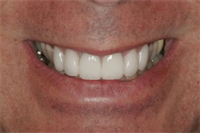by Dr. Jason Olitsky
When you are evaluating the esthetic principles inherent to successful smile design, there are 7 violations that commonly undermine the end result of the finished cosmetic case. Here is one of my top clinical tips for maximizing the outcome of your esthetic cases by using a knowledge of natural smile progression into your approach to the practice of cosmetic dentistry.

Making Esthetic Changes
First to create a genuine looking smile during esthetic changes, the best approach is to consider how to avoid creating a contrast between the color and shape of the anterior and posterior teeth.
There are a few key dentolabial dynamics that can contribute to a smile that doesn’t look fake.
Smile Width
The smile width, a crucial dentolabial dynamics relationship, indicates that a smile will commonly include 10-12 maxillary teeth. As a result, when determining the restorative corrections to make to the smile, much more needs to be taken into account than solely the anterior 6 teeth.
Pre-treatment photos can be great during the evaluation process. Use them to assess front and lateral smile views and to determine how the patient’s smile appears from the side and the front.
Buccal Corridor
Either too much or too little space between the buccal aspects of the teeth and cheek can make or break the success of a smile.
Too much space:
The result of treating only the front six teeth can often be a narrow smile, which is accentuated by an over emphasis on the treated teeth. This will create an artificial look to the smile and can be remedied by referring to the natural smile progression from anterior to posterior teeth.
Too little space:
On the other hand, too little space can contribute to a denture-like look when the buccal aspects of the posterior teeth are brightened during the restoration. Balance is the key.
Again, evaluating photos of the patient’s smile is essential to dealing with potential problems endemic to the buccal corridor. If the pictures show a narrow smile or an issue with the color and contour of existing posterior teeth, then the problem can be recognized and remedied.
Bonus Tip:
Evaluate the relationship between the occlusal and incisal planes to further correct any esthetic shortcomings.
Most of all, make sure to provide the patient with an understanding of the importance of addressing issues in the whole smile rather than just the anterior teeth. Case fees to improve the smile are a great option for the patient to consider.